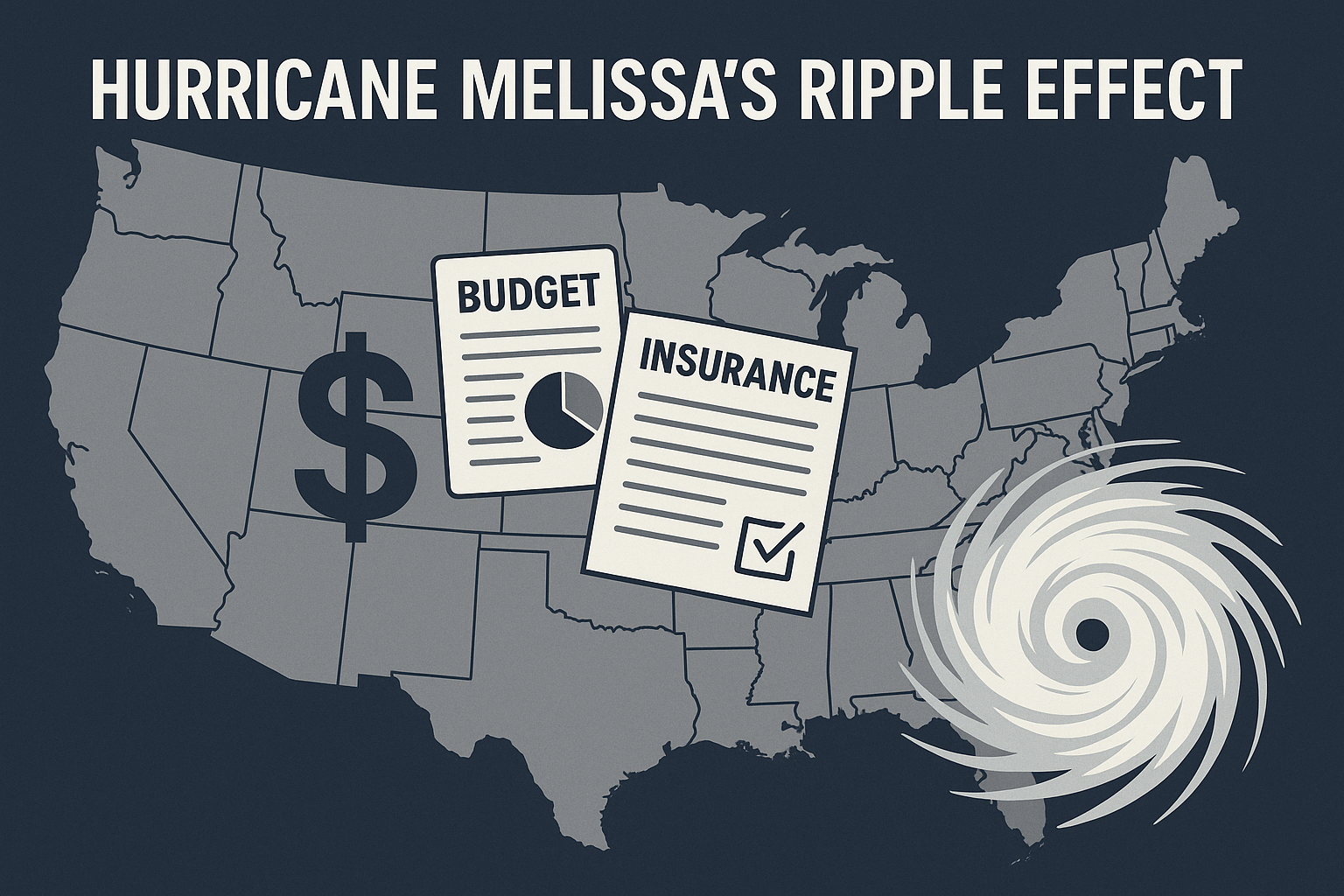As Hurricane Melissa gains strength and threatens to carve a path through the Caribbean, U.S. businesses and fiscal planners are watching closely — even if the storm does not make landfall on American shores. The potential for supply-chain disruption, rising relief costs, heightened insurance exposure, and macro-economic ripple effects makes Melissa relevant well beyond the direct strike zone.
For U.S. corporations, governments, and small businesses, the storm is a reminder: natural-disaster risk is no longer just local — it’s national.
Rising Governmental Costs and Strained Budgets
Even without a direct hit, storms like Melissa amplify fiscal pressures in the U.S.
- The FEMA Disaster Relief Fund (DRF) faces ongoing stress as record numbers of billion-dollar weather events draw down reserves.
- According to the Congressional Budget Office (CBO), disaster-related spending is one of the fastest-growing discretionary costs in the federal budget.
- Each storm triggers costs for debris removal, infrastructure repair, housing support, and local grants — stretching both federal and state budgets thin.
Why it matters for U.S. businesses:
When government budgets tighten, relief and infrastructure programs can be delayed or reduced. Businesses may see slower rebuilding efforts, tighter funding for local support, and new fiscal constraints.
Key takeaway: Monitor how budgetary reallocations from disasters affect the business climate — from infrastructure delays to tax implications.
Disaster Relief Strains & Economic Impacts
Even storms outside the U.S. can disrupt American economic activity by altering supply chains, fuel prices, and trade dynamics.
- The Small Business Administration (SBA) provides disaster loans only in federally declared zones, leaving many indirectly affected firms unsupported.
- Small businesses are overrepresented in disaster-declared counties, showing systemic vulnerability.
- According to NOAA, weather and climate disasters have caused $2.9 trillion in U.S. damages since 1980 — and the cost curve keeps rising.
Impacts U.S. businesses should watch:
- Delays and higher costs in imports if Caribbean ports are damaged.
- Volatile energy prices impacting logistics and manufacturing.
- Rising insurance premiums and stricter underwriting.
- Reduced regional demand for U.S. suppliers in tourism, agriculture, and trade.
Takeaway: Natural disasters anywhere in the Western Hemisphere can ripple through American balance sheets and supply chains.
Preparedness & Support for Small Businesses
Small and medium-sized enterprises (SMEs) remain the most financially exposed during extreme weather events.
Action steps for U.S. small businesses:
- Create a continuity plan: power backup, off-site data storage, alternate suppliers.
- Assess exposure to Caribbean and Gulf logistics hubs vulnerable to hurricane disruptions.
- Stay informed on SBA disaster loans, FEMA assistance, and IRS disaster tax relief programs.
- Collaborate with local chambers and economic-development groups for regional hazard planning.
Summary insight: Preparedness is the cheapest form of insurance. Melissa should prompt SMEs to strengthen resilience before the next storm strikes.
Wider Implications: Insurance, Fiscal Planning & Resilience
Hurricane Melissa also underscores deeper structural challenges in the U.S. risk economy.
- Insurance markets: Rising storm losses drive premium hikes and reduce coverage availability in coastal zones.
- Fiscal planning: The U.S. government’s disaster expenditures are increasingly reactive, consuming funds that could otherwise go toward prevention.
- Corporate strategy: Businesses must integrate risk modeling, diversify supply chains, and treat resilience as a financial discipline — not a PR exercise.
Implications for business leaders:
- Anticipate higher insurance and compliance costs.
- Budget for business continuity as a recurring expense.
- Factor disaster-response lag into strategic forecasting.
- Advocate for stronger public-private partnerships on mitigation.
Bottom line: Melissa is another warning that U.S. fiscal and corporate resilience strategies need to evolve beyond emergency response toward long-term sustainability.
What This Means for the U.S.
Even if Melissa never crosses U.S. soil, it still matters — economically, fiscally, and strategically.
- Budgetary strain: Federal and state budgets must juggle multiple relief demands amid growing deficits.
- Business disruption: Supply-chain and trade linkages expose U.S. industries to foreign storm damage.
- Insurance pressure: Expect higher premiums and stricter policy terms.
- Small-business risk: Local firms without continuity plans are the most vulnerable.
- Economic uncertainty: Disasters contribute to inflationary pressures and slower investment cycles.
Takeaway: Hurricane Melissa illustrates the interconnectedness of global weather events and U.S. financial stability. Preparedness today determines resilience tomorrow.
FAQ
Q: Why should U.S. businesses care if Hurricane Melissa doesn’t make landfall here?
A: Because global supply chains, insurance pricing, and commodity markets respond to risk exposure — even when physical impacts stay offshore.
Q: What disaster support exists for U.S. businesses?
A: The SBA offers low-interest disaster loans, and FEMA provides preparedness and recovery programs for affected firms.
Q: How can small businesses prepare effectively?
A: Develop a continuity plan, diversify suppliers, secure adequate insurance, and monitor FEMA/SBA disaster declarations.
Q: Will insurance premiums rise again?
A: Likely yes — global reinsurance costs and elevated storm activity push insurers to raise rates and narrow coverage.
Q: What’s the long-term takeaway for fiscal policy?
A: The U.S. needs to shift focus from reactive disaster funding to proactive mitigation and climate-resilience investment.
Sources
- NOAA: Billion-Dollar Weather and Climate Disasters (2024)
- Congressional Budget Office: Disaster Preparation and Relief Overview (2024)
- FEMA: Public Assistance and Business Disaster Support Programs
- Small Business Administration: Disaster Assistance Loans
- SBA Office of Advocacy: Small Businesses and Natural Disasters (2024)
- Congressional Research Service: FEMA’s Disaster Relief Fund (2024)
- GAO: Federal Disaster Recovery and Resilience Spending
- CFO2U: Tax Relief Options for Natural Disasters

